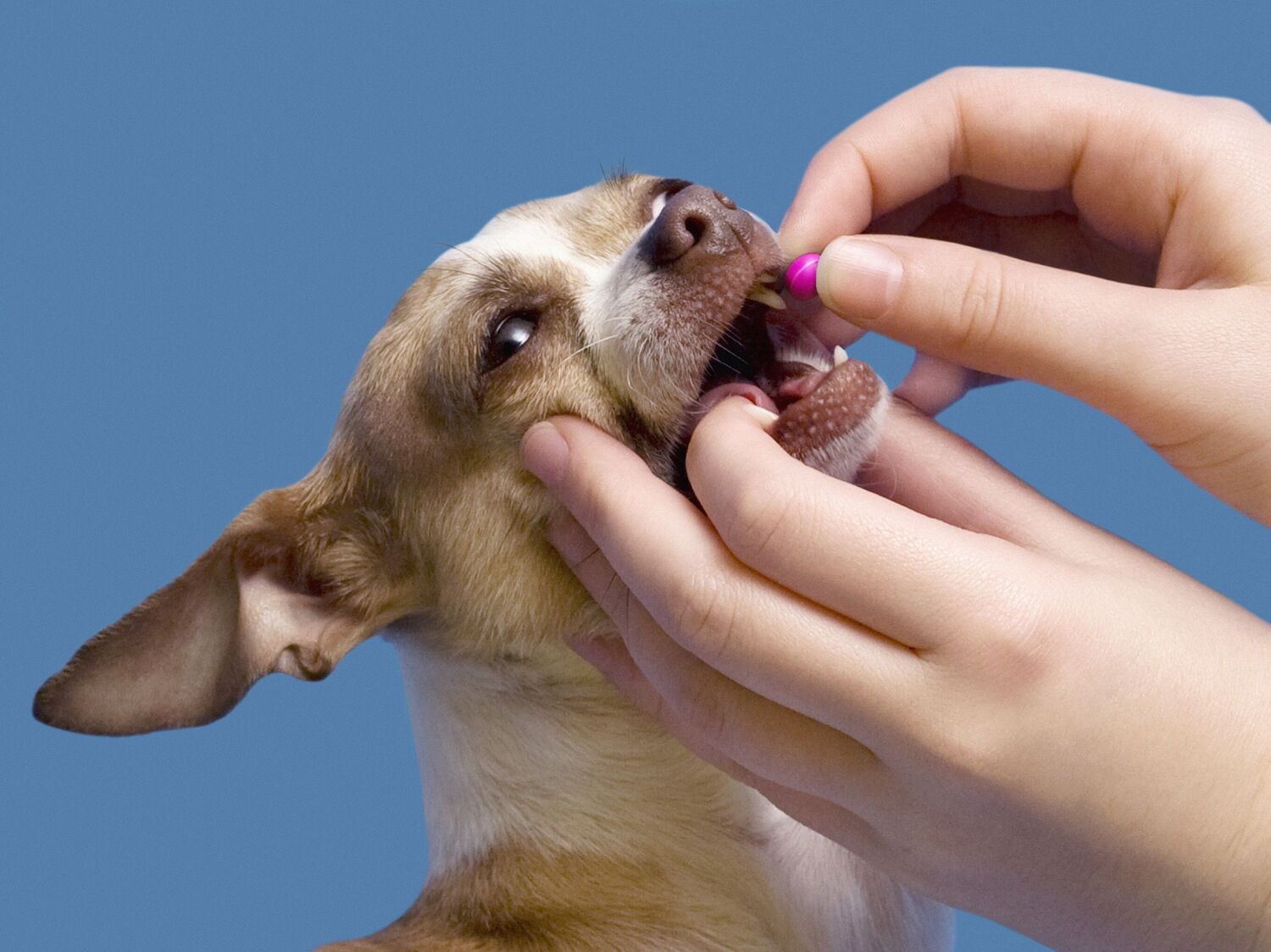Home>Health & Wellness>Common Health Issues>Heart Health>How Long Is Heartworm Treatment For Dogs


Heart Health
How Long Is Heartworm Treatment For Dogs
Published: February 7, 2024
Learn about heartworm treatment for dogs and how long it takes. Ensure your dog's heart health with the right treatment plan.
(Many of the links in this article redirect to a specific reviewed product. Your purchase of these products through affiliate links helps to generate commission for Pawsomeoldies.com, at no extra cost. Learn more)
Table of Contents
Introduction
Heartworm disease is a serious and potentially fatal condition that can affect our beloved canine companions. As responsible pet owners, it's crucial to understand the implications of this disease and the necessary steps to ensure the well-being of our furry friends. Heartworms are parasitic roundworms that can invade the heart, lungs, and blood vessels of dogs, leading to severe health complications if left untreated.
The prevalence of heartworm disease varies across different geographical regions, with a higher incidence in areas with warm and humid climates. Mosquitoes play a pivotal role in the transmission of heartworms, as they serve as carriers for the infective larvae. When an infected mosquito bites a dog, it transmits the heartworm larvae into the bloodstream, initiating the onset of the disease.
The early stages of heartworm infection may not exhibit noticeable symptoms, making it challenging for pet owners to detect the presence of the disease. However, as the condition progresses, dogs may display symptoms such as coughing, lethargy, difficulty breathing, and reduced appetite. If left untreated, heartworm disease can lead to severe damage to the heart, lungs, and other vital organs, posing a grave threat to the overall health and longevity of our canine companions.
In the following sections, we will delve into the various aspects of heartworm treatment for dogs, shedding light on the types of treatment available, factors influencing the duration of treatment, and the essential measures for monitoring and follow-up care. By gaining a comprehensive understanding of heartworm disease and its treatment, pet owners can take proactive steps to safeguard their dogs from this potentially life-threatening condition.
Understanding Heartworm Disease in Dogs
Heartworm disease is a prevalent and potentially life-threatening condition that affects dogs worldwide. It is caused by the parasitic roundworm known as Dirofilaria immitis, which primarily targets the heart, lungs, and blood vessels of infected dogs. The transmission of heartworms occurs through the bite of infected mosquitoes, making it a significant concern in regions with warm and humid climates where mosquitoes thrive.
Once a dog is bitten by an infected mosquito, the heartworm larvae are introduced into the dog's bloodstream. Over time, these larvae mature into adult worms, with the potential to grow up to a foot in length. As the adult worms accumulate within the heart and pulmonary arteries, they impede the normal blood flow and exert detrimental effects on the cardiovascular system.
In the early stages of heartworm infection, dogs may not exhibit overt symptoms, leading to challenges in early detection. However, as the disease progresses, affected dogs may display signs such as coughing, lethargy, exercise intolerance, and difficulty breathing. In severe cases, heartworm disease can result in organ damage, heart failure, and even death if left untreated.
The severity of heartworm disease can vary depending on factors such as the number of worms present, the duration of infection, and the dog's immune response. Additionally, certain breeds, such as retrievers and terriers, may be more susceptible to developing severe complications from heartworm infection.
Preventive measures, including regular administration of heartworm preventatives prescribed by veterinarians, are crucial in mitigating the risk of heartworm disease in dogs. These preventive medications work to eliminate the immature larvae before they develop into adult worms, thereby averting the progression of the disease.
Understanding the insidious nature of heartworm disease underscores the importance of proactive measures to protect our canine companions. By staying informed about the transmission, symptoms, and potential consequences of heartworm infection, pet owners can take proactive steps to safeguard the health and well-being of their beloved dogs.
Types of Heartworm Treatment
1. Immiticide (Melarsomine)
Immiticide, also known as melarsomine, is the primary medication used to treat adult heartworms in dogs. It is administered through a series of deep intramuscular injections to effectively eliminate the adult worms residing in the heart and pulmonary arteries. The treatment typically involves a course of two or three injections, spaced apart to minimize the risk of adverse reactions. Immiticide works by targeting the adult heartworms, causing them to die and gradually disintegrate within the dog's body.
2. Doxycycline
Doxycycline, an antibiotic, is often prescribed in conjunction with melarsomine treatment. This medication serves a dual purpose in heartworm treatment. Firstly, it aids in reducing the bacteria associated with the heartworms, thereby minimizing the risk of complications during treatment. Secondly, doxycycline has been found to exert a detrimental effect on a symbiotic bacterium called Wolbachia, which resides within the heartworms. By disrupting the presence of Wolbachia, the heartworms become more susceptible to the effects of melarsomine, enhancing the efficacy of the treatment.
3. Heartworm Preventatives
In cases where the presence of heartworms is detected in the early stages, veterinarians may opt for a "slow kill" approach using monthly heartworm preventatives. These preventatives, typically administered orally or topically, work to eliminate the immature heartworms (microfilariae) circulating in the dog's bloodstream. While this method may take a longer duration to clear the infection, it can be a viable option for dogs with a high risk of complications from the standard melarsomine treatment.
4. Supportive Care
During the course of heartworm treatment, veterinarians may recommend supportive care measures to alleviate the symptoms and enhance the overall well-being of the affected dog. This may include medications to manage coughing, inflammation, and discomfort associated with the treatment process. Additionally, maintaining a calm and low-stress environment for the dog can contribute to a smoother recovery and minimize potential complications during the treatment period.
5. Exercise Restriction
As part of the treatment protocol, it is essential to restrict the dog's physical activity to prevent exertion that could strain the cardiovascular system. Exercise restriction is crucial in minimizing the risk of complications, such as embolism, during the period when the heartworms are being targeted and eliminated from the dog's body.
Understanding the diverse approaches to heartworm treatment underscores the importance of tailored interventions based on the individual dog's condition and the stage of heartworm infection. By leveraging a combination of medications, preventive measures, and supportive care, veterinarians strive to optimize the treatment outcomes and promote the recovery of dogs affected by heartworm disease.
Factors Affecting the Duration of Heartworm Treatment
The duration of heartworm treatment for dogs can vary significantly based on several key factors, each of which plays a crucial role in shaping the overall treatment timeline. Understanding these factors is essential for pet owners and veterinarians alike, as it provides valuable insights into the complexities of managing heartworm disease in dogs.
-
Severity of Infection: The extent of heartworm infestation within a dog's body is a primary determinant of the treatment duration. In cases where the infection is detected in the early stages, the treatment process may be relatively shorter, as the number of adult worms and microfilariae is limited. Conversely, dogs with a higher burden of heartworms may require a more extended treatment course to effectively eliminate the parasites and mitigate potential complications.
-
Overall Health Status: The general health condition of the affected dog can significantly influence the duration of heartworm treatment. Dogs with underlying health issues or compromised immune systems may experience a prolonged treatment period, as their physiological capacity to combat the infection and respond to the treatment may be diminished. Conversely, dogs in good overall health may exhibit a more robust response to the treatment, potentially shortening the duration required for complete recovery.
-
Presence of Microfilariae: The presence of microfilariae, the immature offspring of adult heartworms, can impact the treatment duration. In cases where microfilariae are present in the bloodstream, additional measures may be necessary to address these offspring, potentially extending the treatment timeline. Veterinarians may employ specific medications or preventive strategies to target and eliminate the microfilariae, contributing to the comprehensive management of the infection.
-
Response to Treatment: The individual response of the dog to the prescribed treatment regimen is a pivotal factor in determining the duration of heartworm treatment. Some dogs may exhibit a rapid and favorable response to the medications, leading to a more expedited recovery process. Conversely, certain dogs may require a more gradual and extended treatment course, necessitating close monitoring and potential adjustments to the treatment plan based on their response.
-
Complications and Concurrent Conditions: The presence of concurrent health conditions or treatment-related complications can impact the overall duration of heartworm treatment. Dogs experiencing adverse reactions to the medications or exhibiting complications such as embolism may require additional supportive care and a more cautious approach to treatment, potentially prolonging the overall recovery period.
By considering these influential factors, veterinarians can tailor the treatment approach to suit the specific needs of each dog, optimizing the efficacy of the treatment while minimizing potential risks and complications. Additionally, proactive measures such as regular veterinary check-ups and adherence to post-treatment guidelines are essential in ensuring the successful resolution of heartworm infection in dogs.
Understanding the multifaceted nature of these factors underscores the importance of a comprehensive and individualized approach to heartworm treatment, ultimately contributing to the well-being and long-term health of our cherished canine companions.
Read more: How Long Will A Dog Live With Heartworm?
Length of Heartworm Treatment for Dogs
The length of heartworm treatment for dogs is a critical aspect that demands careful consideration to ensure the effective management of the disease. The duration of treatment can vary significantly based on several key factors, each of which plays a pivotal role in shaping the overall timeline for addressing heartworm infection in dogs.
The severity of the infection is a primary determinant of the treatment duration. In cases where the infection is detected in its early stages, the treatment process may be relatively shorter, as the number of adult worms and microfilariae is limited. Conversely, dogs with a higher burden of heartworms may require a more extended treatment course to effectively eliminate the parasites and mitigate potential complications.
Furthermore, the overall health status of the affected dog significantly influences the duration of heartworm treatment. Dogs with underlying health issues or compromised immune systems may experience a prolonged treatment period, as their physiological capacity to combat the infection and respond to the treatment may be diminished. Conversely, dogs in good overall health may exhibit a more robust response to the treatment, potentially shortening the duration required for complete recovery.
The presence of microfilariae, the immature offspring of adult heartworms, can also impact the treatment duration. In cases where microfilariae are present in the bloodstream, additional measures may be necessary to address these offspring, potentially extending the treatment timeline. Veterinarians may employ specific medications or preventive strategies to target and eliminate the microfilariae, contributing to the comprehensive management of the infection.
Moreover, the individual response of the dog to the prescribed treatment regimen is a pivotal factor in determining the duration of heartworm treatment. Some dogs may exhibit a rapid and favorable response to the medications, leading to a more expedited recovery process. Conversely, certain dogs may require a more gradual and extended treatment course, necessitating close monitoring and potential adjustments to the treatment plan based on their response.
Additionally, the presence of concurrent health conditions or treatment-related complications can impact the overall duration of heartworm treatment. Dogs experiencing adverse reactions to the medications or exhibiting complications such as embolism may require additional supportive care and a more cautious approach to treatment, potentially prolonging the overall recovery period.
By considering these influential factors, veterinarians can tailor the treatment approach to suit the specific needs of each dog, optimizing the efficacy of the treatment while minimizing potential risks and complications. Proactive measures such as regular veterinary check-ups and adherence to post-treatment guidelines are essential in ensuring the successful resolution of heartworm infection in dogs.
Understanding the multifaceted nature of these factors underscores the importance of a comprehensive and individualized approach to heartworm treatment, ultimately contributing to the well-being and long-term health of our cherished canine companions.
Monitoring and Follow-Up Care
Following the initiation of heartworm treatment, diligent monitoring and comprehensive follow-up care are essential components in ensuring the successful recovery and long-term well-being of dogs affected by heartworm disease. The post-treatment phase necessitates close observation, regular veterinary assessments, and adherence to specific guidelines to optimize the outcomes of the treatment and mitigate potential risks.
Veterinary Check-Ups
Regular veterinary check-ups are integral in monitoring the progress of the dog's recovery post-heartworm treatment. Veterinarians will conduct thorough physical examinations, assess the dog's vital signs, and may perform diagnostic tests to evaluate the response to treatment. These check-ups provide valuable insights into the dog's overall health status, allowing veterinarians to identify any potential complications or lingering effects of the heartworm infection.
Diagnostic Testing
Diagnostic tests, including blood work and imaging studies, may be recommended as part of the follow-up care protocol. Blood tests can help assess the dog's organ function, detect the presence of microfilariae, and monitor the levels of specific biomarkers associated with heartworm disease. Additionally, imaging studies such as chest X-rays may be employed to evaluate the condition of the heart and lungs, providing a comprehensive assessment of the dog's cardiovascular health post-treatment.
Adherence to Activity Restrictions
Following heartworm treatment, adherence to prescribed activity restrictions is crucial in minimizing the risk of complications and supporting the dog's recovery. Veterinarians may recommend a gradual reintroduction of physical activity based on the dog's response to treatment, ensuring that the cardiovascular system is not unduly strained during the recovery period. Strict adherence to activity restrictions can significantly contribute to the successful resolution of heartworm disease and reduce the likelihood of post-treatment complications.
Preventative Measures
Maintaining a proactive approach to heartworm prevention is paramount in safeguarding the dog from future infections. Veterinarians may recommend the continuation of heartworm preventatives and adherence to a regular administration schedule to prevent reinfestation. Additionally, implementing measures to control mosquito exposure, such as using mosquito repellents and minimizing outdoor activities during peak mosquito activity, can further reduce the risk of recurrent heartworm infection.
Ongoing Support and Guidance
Pet owners play a pivotal role in the post-treatment phase by providing a supportive and nurturing environment for their dogs. This includes administering medications as prescribed, closely monitoring the dog's behavior and overall well-being, and promptly reporting any concerning symptoms to the veterinarian. Open communication with the veterinary team and a collaborative approach to post-treatment care can significantly contribute to the dog's recovery and long-term health.
By prioritizing diligent monitoring, proactive follow-up care, and a collaborative partnership between pet owners and veterinary professionals, the post-treatment phase becomes a critical period in ensuring the comprehensive resolution of heartworm disease in dogs. Through meticulous attention to the dog's health status, adherence to post-treatment guidelines, and ongoing preventive measures, pet owners can contribute to the successful recovery and long-term well-being of their beloved canine companions.
Conclusion
In conclusion, the management of heartworm disease in dogs encompasses a multifaceted approach that integrates comprehensive understanding, tailored treatment strategies, and diligent post-treatment care. The intricate nature of heartworm infection, coupled with the diverse factors influencing the treatment duration, underscores the significance of a personalized and vigilant approach to safeguarding the health and well-being of our canine companions.
By delving into the nuances of heartworm treatment, we gain valuable insights into the diverse modalities employed to address this insidious disease. From the administration of melarsomine to the incorporation of supportive care and preventive measures, the treatment landscape is characterized by a nuanced and individualized approach aimed at optimizing the recovery outcomes for affected dogs.
Furthermore, the duration of heartworm treatment is intricately linked to various influential factors, including the severity of infection, the overall health status of the dog, the presence of microfilariae, the individual response to treatment, and the potential for concurrent complications. Understanding and addressing these factors in a tailored manner are pivotal in shaping the treatment timeline and ensuring the comprehensive resolution of heartworm infection.
The post-treatment phase emerges as a critical juncture in the continuum of care, where meticulous monitoring, regular veterinary assessments, and adherence to preventive measures converge to support the dog's recovery and mitigate the risk of recurrent infection. By actively engaging in the post-treatment care protocol and maintaining open communication with veterinary professionals, pet owners play an integral role in fostering the long-term health and well-being of their dogs.
Ultimately, the holistic management of heartworm disease in dogs necessitates a collaborative partnership between pet owners and veterinary professionals, underpinned by a deep commitment to proactive prevention, tailored treatment interventions, and vigilant post-treatment care. By embracing this comprehensive approach, we can strive to mitigate the impact of heartworm disease and cultivate a nurturing environment where our beloved canine companions can thrive free from the burdens of this potentially life-threatening condition.












